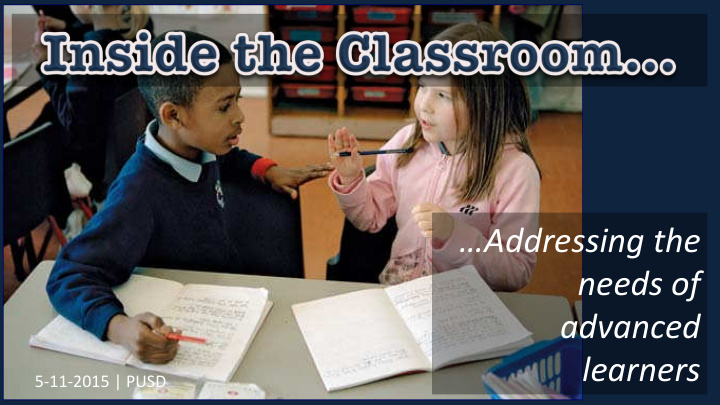



…Addressing ¡the ¡ needs ¡of ¡ advanced ¡ learners ¡ 5-‑11-‑2015 ¡| ¡PUSD ¡
• Born, ¡raised ¡and ¡educated ¡in ¡ the ¡Philippines ¡ • Director ¡of ¡Curriculum, ¡ Instruc@on, ¡PD ¡& ¡SA ¡@ ¡ Eureka ¡Union ¡School ¡District ¡ (K-‑8) ¡ • 20+ ¡years ¡as ¡a ¡teacher, ¡NBCT ¡
• Discuss the WHAT, WHY and HOW of differentiated instruction • Explore UDL as another route to DI • Cluster grouping models
-Electric light bulb, phonograph, and motion picture camera -Wandering mind, “addled brain” and “too stupid to learn” -Dropped out -Home-schooled by school teacher mother Image ¡from: ¡www.biography.com ¡ ¡ ¡
- considered just an “average student.” -Headmaster at school called him a “ poco curante ” (trifler) in front of other boys. Image ¡from: ¡www.biography.com ¡ ¡ ¡
-‑By ¡the ¡age ¡of ¡12, ¡he ¡took ¡it ¡ upon ¡himself ¡to ¡see ¡if ¡he ¡could ¡ learn ¡geometry ¡and ¡algebra ¡on ¡ his ¡own. ¡ ¡ -‑Mastered ¡differenBal ¡and ¡ integral ¡calculus ¡before ¡the ¡ age ¡of ¡15. ¡ Image ¡from: ¡www.blatr.com ¡ ¡ ¡
“ GiEed ¡students ¡are ¡ harmed ¡by ¡the ¡race ¡to ¡ the ¡middle ” ¡ ¡ (Lubinsky, ¡2007) . ¡
75 2 3B 125 Davidson, ¡C. ¡(2011). ¡ ¡Now ¡you ¡see ¡it: ¡How ¡brain ¡science ¡will ¡ transform ¡the ¡way ¡we ¡live, ¡work, ¡and ¡learn. ¡ ¡
At its most basic level, differentiation means ‘ SHAKING UP ’ what goes on in the classroom so that students have multiple options for taking in information , making sense of ideas , and expressing what they learn ” (Tomlinson, 2012).
Teachers can differentiate… Content Process Product …According to students ’ v ¡ Learning Readiness Interest Preferences
• Structures designed for the ‘average’ individual. – Require retrofitting to accommodate others • Retrofits are expensive, call attention to non-average user, and solve one problem at a time. From: ¡Dr. ¡B. ¡G. ¡Cook, ¡ Professor, ¡University ¡of ¡Hawaii ¡
• Universal design considers “ broadest possible range of users from the beginning ” (Ron Mace, architect) • Examples: Ramps, curb cuts, electric doors, TV captions, easy grip tools • Increases access for many unintended users From: ¡Dr. ¡B. ¡G. ¡Cook, ¡Professor, ¡University ¡of ¡Hawaii ¡
“ The design of Essentially, pro- instructional materials active lesson and activities that makes the learning goals planning to meet achievable by the needs of individuals with wide diverse learners. differences in their abilities . ” -Council for Exceptional Children From: ¡Dr. ¡B. ¡G. ¡Cook, ¡Professor, ¡University ¡of ¡Hawaii ¡
What are the qualities of successful gifted programs in schools? 1. Opportunities for intellectual peer interactions 2. Flexible grouping 3. Differentiation of curriculum and instruction 4. Continuous academic progress 5. Continuity of support services 6. Teachers with specialized training in gifted education.
• In SCGM, all students in a grade level are grouped according to their abilities and achievement levels. • The model creates a balance of ability and achievement across each grade level, yielding desirable outcomes that benefit all student (Winebrenner & Brulles, 2010).
Class ¡1 ¡ Class ¡2 ¡ Class ¡3 ¡ 10 ¡giEed ¡ 12 ¡high-‑ 12 ¡high-‑ students ¡ achieving ¡ achieving ¡ 10 ¡average ¡to ¡ 26 ¡average ¡to ¡ 10 ¡average ¡to ¡ low ¡average ¡ low ¡average ¡ low ¡average ¡ 10 ¡low ¡ 10 ¡low ¡ performing ¡ performing ¡
Although ¡all ¡teachers ¡sBll ¡ have ¡heterogeneous ¡ classes, ¡the ¡student ¡ achievement ¡range ¡in ¡each ¡ class ¡is ¡slightly ¡narrowed, ¡ When ¡not ¡placed ¡with ¡ which ¡facilitates ¡effecBve ¡ idenBfied ¡giEed ¡ teaching. ¡ ¡ students, ¡high-‑achieving ¡ students ¡oEen ¡emerge ¡ as ¡new ¡academic ¡ GiEed ¡students ¡receive ¡full-‑ leaders ¡in ¡their ¡own ¡ Bme ¡aKenBon ¡to ¡their ¡ classes. ¡ excepBonal ¡learning ¡needs, ¡ allowing ¡them ¡to ¡progress ¡ at ¡their ¡own ¡pace ¡in ¡an ¡ inclusionary ¡seMng. ¡ Image ¡source: ¡www.theendinmind.net ¡
Lancaster, ¡P. ¡(2011). ¡Universal ¡design ¡for ¡learning. ¡ Colleagues , ¡ 3 , ¡1, ¡5. ¡ ¡Retrieved ¡from: ¡ ¡ ¡h]p://scholarworks.gvsu.edu/cgi/viewcontent.cgi?ar@cle=1070& ¡ ¡context=colleagues ¡ ¡ Subotnik, ¡R. ¡F., ¡Olszewski-‑Kubilius, ¡P., ¡& ¡Worrell, ¡F. ¡C. ¡(2011). ¡Rethinking ¡gieedness ¡and ¡ ¡ ¡gieed ¡educa@on ¡A ¡proposed ¡direc@on ¡forward ¡based ¡on ¡psychological ¡ ¡science. ¡ Psychological ¡Science ¡in ¡the ¡Public ¡Interest , ¡ 12 , ¡1, ¡3-‑54. ¡Retrieved ¡ ¡from: ¡ ¡www.apa.org ¡ ¡ Lubinski, ¡D. ¡(2004). ¡Long-‑term ¡effects ¡of ¡educa@onal ¡accelera@on. ¡ A ¡naBon ¡deceived: ¡ ¡ ¡How ¡schools ¡hold ¡back ¡America’s ¡brightest ¡students , ¡ 2 , ¡23-‑38. ¡ ¡Retrieved ¡ ¡ ¡from: ¡h]p://accelera@onins@tute.org/Na@on_Deceived/ND_v2.pdf#page=32 ¡ ¡ Winebrenner, ¡S., ¡& ¡Brulles, ¡D. ¡(2008). ¡The ¡schoolwide ¡cluster ¡grouping ¡model ¡ ¡ ¡(SCGM). ¡ GiEed ¡EducaBon ¡Press ¡Quarterly, ¡22 , ¡2. ¡Retrieved ¡from: ¡ ¡ ¡h]p://wsfcs.k12.nc.us/cms ¡ ¡
Recommend
More recommend